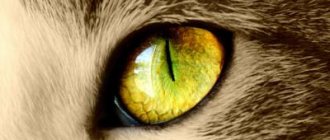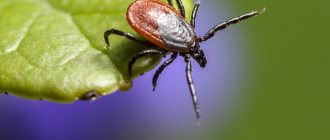Adult worms Toxascaris Leonina
Toxascaris Leonina is a helminth of the Roundworm type, which, when parasitized in animals, causes toxascariasis. The definitive hosts are dogs, cats and all other representatives of the Canine and Feline families. It is believed, although there are controversial points, that in rare cases a person (mainly children) can become infected, but in his body the parasite, as a rule, does not develop to a sexually mature individual, and after hatching it enters the bloodstream and can cause the visceral form of larva migrans syndrome, as with toxocariasis.
The helminth Toxascaris Leonina is not considered a causative agent of toxocariasis in humans. This disease is caused by two more common relatives from the same family, but the genus Toxascara (Toxascara) - canine Toxocara (T. canis) and feline Toxocara (T. cati).
Life cycle
The life cycle of the parasite, unlike Toxocara (T. cati, T. canis), is quite simple.
The female lays eggs, which are then released in the animal's feces. The larva inside the egg molts for the first time within 4 days, depending on environmental conditions. After this, the egg becomes invasive (infectious).
The egg is swallowed by animals, settles in the small intestine, where the larva hatches from it. It penetrates the intestinal mucosa, where it sheds twice. After growth and molting, it returns to the intestinal lumen, where it molts for the last time and reaches maturity.
The natural definitive hosts of Toxascaris Leonina are cats and dogs; rodents can sometimes act as intermediate hosts, within which the larvae are able to encapsulate and wait.
A distinctive feature of Toxascaris Leonina from Toxocara canis and Toxocara cati is the absence of migration in the body of the final host. The entire life cycle takes place in the intestines.
Therapeutic procedures
*Effective against the following types of parasitic worms:
- R = Roundworms
- H = Hookworm
- W = Whiplashes
- F = Fleas
- TT/FT = Cestodes
- ET = Echinococcus and Alveococcus
**Also used to kill heartworms
Please note that complete treatment does not imply just a one-time prescription of the drug. The fact is that “sleeping” larvae can always remain in the dog’s body. It is for this reason that the therapeutic course must be repeated after 10-14 days. In general, ideally, the animal should be treated until three negative stool test results are obtained (in a row, of course). In such a situation, you can definitely guarantee that there are no parasites left in the dog’s body. In addition, if there is an unfavorable situation with ascariasis in your area, the dog’s feces should be examined at least once a month.
Prevalence
Toxascaris Leonina is found in almost all countries of the world. The highest incidence rates are observed in rural areas, where wild carnivores are spreaders. A study in Switzerland found that about 60% of foxes in rural areas were infected with Toxascaris Leonina, compared to only about 8% in urban areas.
In cities, the largest number of helminth eggs was recorded in dog walking areas, as well as in animal kennels. Domestic cats and dogs are less at risk than strays.
Toxascaris Leonina is significantly less common than Toxocara canis (about 20% versus about 45%, respectively).
Differential diagnosis of helminthiases in dogs
I. N. Dubina, Ph.D. vet. Sciences, Vitebsk, Belarus
Parasitic diseases of dogs are widespread and are characterized by a pronounced diversity of pathogens. In the Republic of Belarus, helminthiasis dominates in the structure of parasitic diseases of dogs.
The problem of parasitic diseases caused by helminths is currently very relevant. An increase in the number of domestic and stray dogs and cats, a decrease in walking areas and their unsanitary condition contribute to the contamination of the environment with helminth eggs. Studies show that during one act of defecation, a dog infested with taeniids can excrete from 400 to 27,000 helminth eggs [6].
Parasitic diseases caused by helminths often lead to the death of animals, especially at a young age. The intensity of immunity during vaccination of dogs and cats infected with helminths may be low, which leads to the occurrence of infectious diseases. In dogs, due to parasitic infestation, working and service qualities are reduced with a deterioration in conformation indicators [11,12].
Conducting a thorough helminthological examination of small domestic animals is necessary for the prevention of zoonotic invasion by human helminths. In the territory of the former Soviet Union, more than 82 types of helminths have been registered in dogs, of which 36 are dangerous to humans and 26 are only dangerous to animals. However, of all this diversity, only about 20 species are of practical importance: Toxocara canis, Toxascaris leonina, Ancylostoma caninum, Uncinaria stenocephala, Tominx aerophilus, Taenia pisiformis, Taenia hudatigena, Echinococcus granulosus, Alveococcus multilocularis, Multiceps multiceps, Dipylidium caninum, Diphyllobothrium latum , Opisthorchis felineus, Alaria alata, etc. [2,7,8,11].
| Photo 1. Egg of Toxocara canis. | Photo 2. Egg of Toxascaris leonina. |
The biology of helminths in dogs, given the awareness of specialists on this issue, is not discussed in this article.
In everyday practice, veterinarians, faced for a number of reasons with the problem of making a final diagnosis of parasitic infestation of small domestic animals, are guided mainly by data from the epizootic situation in the region.
The purpose of this research is to determine the influence of the environment on the helminth fauna of dogs and to carry out differential diagnosis of eggs and adult forms of parasites.
Materials and methods
A complete and partial helminthological examination of 407 dogs in the Republic of Belarus was carried out. Animals, taking into account their habitat, were divided into 4 groups (Table 1):
- hunting dogs that regularly take part in hunting;
- rural dogs (domestic and belonging to organizations in rural areas);
- city dogs (domestic and those belonging to city enterprises and institutions);
- stray dogs.
All animals were subjected to scatological examination for helminth eggs using native smears, the methods of Fulleborn, Darling, Shcherbovich, Kotelnikov, Khrenov, as well as sequential washing [3,5,10,12].
Table 1. The prevalence of helminths in dogs in the Republic of Belarus depending on their habitat.
| Type of helminth | Hunting dogs, % (n=67) | Rural dogs, % (n=117) | City dogs, % (n=161) | Stray dogs, % (n=62) |
| Taenia pisiformis | 31,34 | 29,05 | 11,18 | 9,67 |
| Tania hydatigena | 8,95 | 9,4 | — | — |
| Echinococcus granulosus | 10,44 | 19,65 | 0,64 | 4,83 |
| Diphyllobothrium latum | 1,49 | 1,7 | — | — |
| Spirometra erinacei-europaei | 4,47 | 1,7 | — | — |
| Dipylidium caninum | 14,92 | 33,33 | 14,1 | 30,64 |
| Mesocestoides lineatus | 2,98 | 1,7 | — | 4,83 |
| Toxocara canis | 11,94 | 7,69 | 14,28 | 20,96 |
| Toxascaris leonina | 7,46 | 9,4 | 6,83 | 16,12 |
| Uncinaria stenocephalus | 8,95 | 5,98 | 4,34 | 27,41 |
| Ancylostoma caninum | 5,97 | 5,98 | 5,59 | 19,35 |
| Trichocephalus vulpis | 4,47 | 3,41 | 1,24 | 4,83 |
| Tominx aerophilus | — | 0,85 | 0,62 | 3,22 |
| Capillaria plica | 1,49 | — | 1,24 | 4,83 |
| Trichinella spiralis | 1,49 | — | — | 1,61 |
| Opisthorchis felineus | 4,47 | 3,41 | 0,62 | — |
| Alaria alata | 4,47 | 4,27 | — | 8,06 |
| Dicrocoelium dendriticum | — | — | — | 3,22 |
| Pseudomphistomum truncatum | — | 0,85 | — | — |
If infestation of dogs by cestodes was suspected, diagnostic deworming was performed by administering arecoline hydrobromide.
Urine taken to detect helminth eggs was centrifuged, followed by microscopy of the sediment.
The species of eggs and mature forms of helminths (imagoes) found in the studied material was determined by their morphological characteristics (shape, structure of the shell and internal structure, color and size). Atlases on helminths of agricultural animals were used for identification [9,13]. A study was carried out on muscle tissue for the persistence of trichinosis in two dead dogs.
| Photo 3. Egg of Ancylostoma caninum. | Photo 4. Egg of Uncinaria stenocephala. |
Research results
By parasitizing the body of dogs, helminths can affect almost all organs and systems with the manifestation of diseases of varying degrees of severity. The main sign of helminthiasis in the dogs subject to the study was a gradual decrease in their weight; the following symptoms were also observed:
- violation of the act of defecation (diarrhea or constipation);
- decreased or increased appetite;
- vomit;
- depression;
- tension and pain in the abdominal wall during palpation;
- dehydration caused by prolonged diarrhea;
- nervous manifestations (convulsions, trembling muscles), especially in puppies;
- sometimes fever.
It is impossible to make a diagnosis of helminthiasis based on the nonspecific clinical signs listed above. In this regard, at present, laboratory research methods remain the only reliable method for diagnosing diseases caused by helminths.
Of the 407 dogs subjected to testing for parasitic infestation, the presence of helminths could be established in 264 animals, which amounted to 64.86%.
The highest degree of helminth infection was noted in the group of stray dogs - 82.25%, while in rural and hunting dogs the incidence of helminths was 76.06 and 71.64%, respectively. The lowest level of invasion was observed in dogs living in urban environments and having owners (47.2%).
A total of 19 species of helminths were recorded in animals: 7 species of cestodes, 8 species of nematodes and 4 species of trematodes (Table 1).
Of these, 12 species are biohelminths (presence of intermediate hosts), 7 are geohelminths (direct transmission).
| Photo 5. Egg of Trichocephalus vulpis (Trichuris vulpis). | Photo 6. Egg of Tominx aerophilus (Capillaria aerophila). |
The greatest diversity of parasites was found in hunting and rural dogs (16 species in each group), while 11 species of helminths were registered in urban dogs.
Of the 19 species, 16 were classified as potentially dangerous to humans (Toxocara canis, Toxascaris leonina, Ancylostoma caninum, Uncinaria stenocephala, Tominx aerophilus, Trichinella spiralis, Taenia hudatigena, Echinococcus granulosus, Alveococcus multilocularis, Multiceps multiceps, Dipylidium caninum, Diphyllorium latum, Spirothome tra erinacei -europaei, Opisthorchis felineus, Alaria alata, Pseudomphistomum truncatum); 6 - for farm animals (Taenia pisiformis, Taenia hуdatigena, Echinococcus granulosus, Alveococcus multilocularis, Multiceps multiceps, Alaria alata); 8 - for game animals (Taenia pisiformis, Taenia hуdatigena, Echinococcus granulosus, Spirometra erinacei-europaei, Opisthorchis felineus, Alaria alata).
The most common species among helminths in dogs is Dipylidium caninum (22.35%), and in rural and stray dogs it was recorded in almost every third individual, in which a high degree of damage by fleas and trichodectes (intermediate hosts of D. caninum) was noted.
The second most common place is occupied by Taenia pisiformis (19.41%). Dogs that take part in hunting and live in rural areas were more affected.
| Photo 7. Capillaria plica egg. | Photo 8. Eggs of helminths of the family. Taeniidae (Taenia pisiformis, Taenia hуdatigena, Echinococcus granulosus, Alveococcus multilocularis, Multiceps multiceps). |
| Photo 9. Cocoon of Dipylidium caninum. | Photo10. Egg of helminths family. Diphyllobothriidae (Diphyllobothrium latum, Spirometra erinacei-europaei). |
Toxocara canis was found to be present in 13.02% of the examined animals. Stray and domestic city dogs are largely affected by this type of helminth.
Almost the same degree of distribution in stray dogs of Toxascaris leonina and Uncinaria stenocephala (9.09%) was noted.
The detection rate of Echinococcus granulosus (a pathogen that can cause disease in humans with possible fatal outcome) was 8.35%, with a predominance in dogs that take part in hunting and live in rural areas.
Cestodes potentially dangerous to humans (Taenia hydatigena, Diphyllobothrium latum, Spirometra erinacei-europaei) were not identified in either urban or stray dogs.
The most rarely encountered nematode species was Trichinella spiralis (0.49%). The persistence of the pathogen was discovered when examining muscle tissue from one dead hunting dog and one stray dog.
Of the 4 species of trematodes, 3 were found in animals in rural areas. Only one zoonosis (O. felineus) was identified in the city.
Alaria alata is the most common fluke species in hunting, rural and stray dogs (3.19%). In stray animals, the extent of alaria infestation is higher (8.06%). Infection with this helminthiasis occurs by eating frogs infested with metacercariae.
In stray animals, helminths whose intermediate host is fish (D. latum, O. felineus, P. truncatum) could not be detected. The highest degree of invasion in this group of animals was noted by the cestode Mesocestoides lineatus and the trematode Dicrocoelium dendriticum, infection of which occurs through intermediate hosts - oribatid mites and ants (eating grass).
Based on the analysis of the helminth fauna in various groups of dogs, it was noted that the most common types of helminths in hunting dogs include T. pisiformis, D. caninum, T. canis, E. granulosis, T. hydatigena, U. tenocephala; in rural dogs D. aninum, T. pisiformis, E. ranulosis, T. hydatigena, T. leonina, T. canis; in domestic city dogs T. canis, D. caninum, T. pisiformis, T. leonina, A. caninum and in stray dogs - D. caninum, U. stenocephala, T. canis, A. caninum, T. leonina (Table 1 ).
As studies have shown, helminths that secrete eggs with very similar morphological properties are widespread in dogs, so difficulties often arise in their differentiation (Toxocara canis - Toxascaris leonina; Ancylostoma caninum - Uncinaria stenocephala; Trichocephalus vulpis - Tominx aerophilus; Diphyllobothrium latum - Alaria alata ).
The morphological characteristics of helminth eggs, which are most widespread in dogs, are presented in photos 1-12.
| Photo 11. Opisthorchis felineus egg. | Photo 12. Alaria alata egg. |
When eggs of the taeniid type were detected in dogs (photo 8), taking into account their identity, a thorough examination of the feces was carried out to detect segments that made it possible to establish the species affiliation of the helminths.
During microscopy of segments discolored with lactic acid, or during diagnostic deworming, their species was determined based on the morphological characteristics of the released strobila. Thus, the following species of taeniids were identified: Taenia pisiformis - Taenia hudatigena - Multiceps multiceps; Echinococcus granulosus - Alveococcus multilocularis (Table 2).
Table 2. Morphological properties, mode of transmission and location of taeniids in the body of dogs.
| Tenia pisiformis | Tenia hydatigena | Echinococcus granulosus | Alveococcus multilocularis | Multiceps multiceps | |
| Mature proglotids | |||||
| Number of lateral branches (×2) | 8-10 | 5-10 | — | — | 9-16 |
| Number of hooks | 24-28 | 26-44 | 30-42 | 26-36 | 22-32 |
| Dimensions (µm): - large hooks - small hooks | 210-290 130-175 | 170-220 110-160 | 24-40 19-35 | 25-29 19-24 | 150-170 90-130 |
| Egg diameter (µm) | 32-42 | 34-38 | 32-36 | 25-30 | 30-37 |
| Intermediate host | Rabbits, hares, rats, mouse-like rodents | Sheep, goats, cattle, pigs, wild ruminants, wild boars | Pigs, sheep, cattle, wild boars, moose, bison, etc. | Muskrats, nutria, rats, mouse-like rodents | Sheep, goats, cattle, etc. |
| Larval stage | Cisticercus pisiformis | Cisticercus tenuicolis | Echinococcus granulosus larva | Alveococcus multilocularis larva | Coenurus cerebralis |
| Localization | Serous coverings of the abdominal organs | Serous covers of the abdominal and thoracic cavities | Parenchyma of the liver, lungs, kidneys | Parenchyma of the liver, lungs | Brain |
Discussion
In terms of the extent of invasion and species composition, cestodes clearly dominated in hunting and rural dogs, while nematodes dominated in stray and urban dogs, which must be taken into account when carrying out deworming.
The high level of damage to rural and hunting dogs by taeniasis, on the one hand, indicates the widespread distribution of larval forms of cestodes such as Cysticercus pisiformis, Cysticercus taenuicollis and Echinococcus granulosus among agricultural and hunting animals. On the other hand, this indicates the lack of education of rural residents and hunters in this area: feeding dogs internal organs, slaughter waste, contaminated with cestode larvae, leads to infection of animals [6].
The presence of trichinosis infestation in hunting dogs indicates that, contrary to existing instructions, hunters in some cases, due to poaching, do not carry out trichinoscopy of the carcasses of wild boars they have shot. This can lead to human infection with trichinosis. In the period from 1999 to 2002 In the Republic of Belarus, 268 people are registered with this parasitic disease [4].
Conclusion
If dogs experience weight loss, diarrhea or constipation, scatological tests should be performed to diagnose parasitic diseases.
Of the 407 dogs examined, 264 had helminthiasis (64.86%). The prevalence of helminths in hunting dogs was 71.64%, rural - 76.06%, urban - 47.2%, stray - 82.25%. The most common types of helminths in dogs are Dipylidium caninum (22.35%), Taenia pisiformis (19.41%), Toxocara canis (13.02%), Toxascaris leonina (9.09%), Uncinaria stenocephala (9.09% ), Echinococcus granulosus (8.35%).
The habitat and economic use of dogs have a significant impact on the helminth fauna of dogs. In the helminth fauna of rural and hunting dogs, the predominance of cestodes is pronounced; in urban and stray dogs, nematodes dominate.
Reliable diagnosis of helminth infections and determination of the type of parasitic helminth are possible only using laboratory diagnostic methods. When determining the species of helminth eggs, it is necessary to take into account their morphological characteristics, color and size.
To determine the type of parasitic taeniids, it is necessary to study the morphological characteristics of their segments or the entire strobila.
One of the important tasks when carrying out preventive measures by veterinarians is educational work among the population.
LITERATURE: 1. Akbaev M.Sh. Parasitology and invasive animal diseases. - M.: Kolos, 1998. 2. Diseases of dogs / A.D. Belov, E.P. Danilov, I.I. Doukur et al. - M.: Kolos, 1995. 3. Veterinary parasitology / G.M. Urquhart, J. Ermur, J. Duncan, etc. - M.: Aquarium LTD, 2000. 4. Helminthiases, protozooses, vector-borne zoonoses, infectious skin and venereal diseases in the Republic of Belarus: Analytical Bulletin / Republican Center for Hygiene and Epidemiology. - Minsk, 2002. 5. Demidov N.V. Helminthiases of animals. - M.: Agropromizdat, 1987. 6. Dubina I.N., Karasev N.F. Larval cestodiasis of animals in Belarus, measures for their prevention and elimination // Veterinary Medicine of Belarus. - 2003. - No. 1. 7. Dubina I.N., Subbotin A.M., Karasev N.F. Helminth fauna of dogs in the Republic of Belarus // Modern parasitology: problems and prospects: Mat. scientific pract. conf. - Vitebsk, 1999. 8. Esaulova N.V. Helminth infections of dogs and cats, dangerous to humans // Veterinary. - 2002. - No. 6. 9. Kapustin V.F. Atlas of helminths of farm animals. - M.: State Publishing House of Agricultural Literature, 1953. 10. Hendix CM Diagnostic Veterinary parasitology // Mosby-Year Book. - 1998 11. Kasai T. Veterinary Helminthology // Butterworth-Heinemann Medical. - 1999. 12. Reinecke RK Veterinary helminthology. - Durdan: Butterworths, 1983. 13. Theienpont D., Rochette F. Diagnosing Helminthiasis by coprological examination // Janssen Research Koundation. - Beerse, Belgium, 1986.
SVM No. 5/2003
Tags Parasitology
Harm to animals
In most cases, Toxascaris Leonina infection in cats and dogs is asymptomatic. However, with severe infestation, serious consequences are possible.
Helminths have mechanical and toxic effects on the body of the final host. In case of severe invasion, blockage of the intestinal lumen is possible. Sometimes perforation or rupture of its walls may occur, resulting in peritonitis. Mature individuals are able to enter the liver and bile duct, which causes disruption of the biliary system. In addition, mechanical damage to the intestinal walls is the “entry gate” for bacterial and viral infections of the gastrointestinal tract.
The disease in animals is accompanied by severe exhaustion, as well as pallor of the mucous membranes. As a rule, appetite decreases. Indigestion is manifested by alternating constipation and diarrhea. The eggs of the parasite are found in the feces, saliva and vomit of the animal.
It has been established that adults and young individuals (over 6 months of age) are more likely to suffer from toxascariasis. While other major members of the genus Toxocara primarily affect puppies and kittens.
Treatment is based on the use of anthelmintics that are effective against intestinal roundworms, such as pyrantel for dogs and cats, piperazine, mebendazole, febantel, etc.











